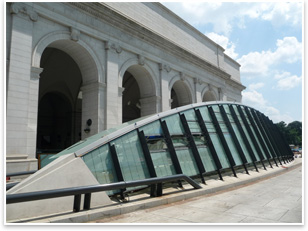D.C. Bicycle Transit Center Speeds to Completion in Graceful Glass and Steel
Free of bike locks, patrons will be able to park, change clothes, and shop
by Zach Mortice
Associate Editor
Summary: It’s a simple maxim of urban life that the decision to drive or not has more to do with a dearth of parking options at the destination than with an abundance of traffic congestion along the way. The fact that this applies to bicycles as well as cars is acknowledged by the Bicycle Transit Center that’s nearing completion next door to Union Station in Washington, D.C.

The transit center is supported by three longitudinal steel pipes. Images Courtesy of KGP Design Studio.
This sustainable transit facility, designed by KGP Design Group of Washington, will feature approximately 150 bike rack parking spaces, changing rooms, personal lockers, and retail spaces for bike repair and bike accessories, all in a secure and semi-enclosed environment next door to a major interstate rail link and a station in the city’s Metro subway system. At the transit center, patrons will be able to sign up for memberships or pay a small fee per day to lock their bike in one of the secure double height bike racks that will take up two-thirds of the building’s space. The $3 million project is being funded by the District of Columbia Department of Transportation, and is currently scheduled to open in the fall.
The 1,700-square-foot facility (which is to be the first of its kind on the East Coast, according to the Washington Post) is an ovular glass and steel sliver nestled between Daniel Burnham’s grand Beaux Arts Union Station and the National Postal Museum to the west. District of Columbia Department of Transportation officials first suggested a cinder block design for the building that more literally mimicked the masonry of Union Station, but the architects at KGP instead chose to use sharp material oppositions to bring the project into focus. Still, its shallow vaulting curves are a contextual parallel to the train station’s arched colonnades.
It’s organic massing, lack of strictly defined “walls,” and total transparency allows lines of sight to flow over the building and broadcast its purpose as a unique carbon-neutral transit hub. The west side of the bicycle center is a single plane of partially fritted glass with vertical steel louvers to block excess sunlight. The east side is formed by interlocking glass planes (a bit like a shell or bicycle helmet) supported by long, thick longitudinal steel tube structural members. The building terminates in concrete points at both ends. Held in compression, these structural elements resemble the graceful arcs and curves of a bicycle frame or a rim-and-spoke wheel. “There are probably simpler ways to structure it, but there’s quite a bit of economy in [this],” says Donald Paine of KGP, about the building’s structure.

Steel louvers on the west side of the building block excess sunlight, and the transit center’s arcing massing subtly echo Union Station’s colonnades.
Bikestation a socially minded bicycle transit company, is assisting the District of Columbia DOT in establishing the transit center. From their home base in Long Beach, Calif., Bikestation has established several similar facilities on the West Coast. Recently, their investments in bicycle transit infrastructure have been echoed by cities’ efforts to mandate and improve bike parking regulations. New York, Philadelphia, and Santa Ana, Calif. have all made it easier to ride and park a bicycle as part of an everyday commute. According to Slate, Pittsburgh’s planning department is considering requiring one specifically designated bicycle parking space for every 20,000 feet of development, and pilot programs in Chicago and Los Angeles are investigating ways to improve car parking meters so they can be used as bike parking spaces.
But even these efforts pale in comparison to the infrastructure and design investments European and Asian nations have made in bicycle transit (where parking structures’ capacity is measured in the thousands, not the hundreds). Domestically, this scale of bike infrastructure has to be approached before Americans will regard a bike commute as commonly as a trip in a car or subway, Paine says. “For the bike stations to work, there have to be more bike stations,” he says.
|




